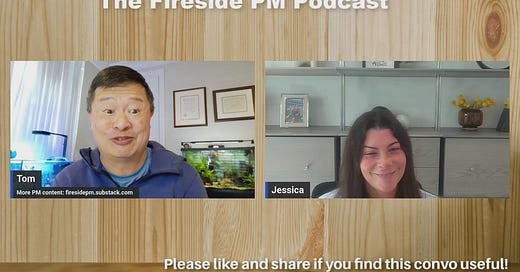When Jess Gilmartin talks, I listen. If you've been in Silicon Valley long enough, you might have heard of Jess. She's been a full-time CMO, a founder, a startup whisperer, and most recently, one of the sharpest advisors to CEOs I know when it comes to hiring marketing leadership that actually works.
In our recent Fireside PM conversation, we went deep on the do's and don'ts of hiring a CMO. While many of my listeners and readers are early- to mid-career product managers, this interview is packed with insight relevant not just to founders and CEOs but to any PM who will eventually be part of a hiring panel, collaborating with marketing peers, or considering their own path to executive leadership.
Why Your Company Even Needs a CMO
Let’s start with first principles. As Jess puts it:
“The CMO is the steward of the brand. And brand isn’t just your website or ads—it’s every interaction a customer has with your company. That includes your support team, your social media presence, your onboarding experience, and yes, your product.”
The reason this matters for PMs is simple: we often underestimate the scope and gravity of the brand experience. We build features. We define roadmaps. But we rarely think of the emotional resonance of what we’re building.
“Part of the job is ensuring consistency and excellence across all these touchpoints,” Jess said. "That also means having the spine to flag when something the product team is doing will degrade that experience."
Translation? If you think marketing's job is to "wrap" your product after the work is done, you're missing the point.
What Great CMOs Actually Do (Hint: It’s Not Just Marketing)
One of the biggest wake-up calls for me was hearing Jess talk about the real job of a modern CMO:
“When I was a CMO, I had senior leaders under me running product marketing, growth, and comms. I spent most of my time on executive alignment, crisis communications, and internal messaging. I was rarely in the weeds.”
That division of labor is a signal. The difference between a head of marketing and a CMO isn’t just title inflation—it’s scope. A CMO thinks in systems. They think in multi-stakeholder alignment. And above all, they should be one of the CEO’s most strategic advisors.
Jess broke it down this way:
“The biggest mistake founders make is hiring too senior or too junior a marketer for where they are. If you're still pre-product-market-fit, don’t hire a head of marketing. You need to be doing that work yourself.”
As someone who has worked with a lot of pre-PMF startups, I couldn’t agree more. And yet, time and time again, I see companies try to paper over early churn or stagnant growth with splashy campaigns and SEO spend.
It doesn’t work.
Product Managers: Here’s What You Keep Getting Wrong
There was one part of our conversation where my PM blood pressure rose just a bit. I asked Jess what she does when she’s in a cross-functional meeting and the product team is proudly showcasing something... that isn’t actually great for the user experience.
She smiled:
“I try not to have strong opinions on product. That’s not my job. But I deeply understand the customer experience. And when I see something that isn’t going to land, I raise a fuss. Not all the time—you have to pick your battles—but marketing sees across silos. We’re often the ones that spot inconsistencies in the end-to-end experience.”
PMs, listen carefully to that last part.
We often live in silos—focused on our vertical, our feature, our sprint velocity. Meanwhile, marketing is scanning horizontally, sensing what happens when someone tries to connect the dots. That perspective is invaluable. And if you're lucky enough to work with a CMO or a senior PMM who raises their hand about UX inconsistencies or cross-functional misalignments, treat that as signal, not noise.
The Dirty Truth About CMO Tenure
Ready for the most sobering stat of the interview?
“Most CMOs last two years,” Jess said flatly.
Why? Expectations are sky-high. CEOs want the creativity of Nike, the analytics of Facebook, the virality of TikTok, and the demand gen of HubSpot—all in one human. Oh, and don’t forget crisis PR, event strategy, and internal morale-boosting Slack posts.
That level of sprawl is untenable.
“Marketing is the only function where we expect a single person to be excellent at creative, numbers, product thinking, storytelling, operations, hiring, and analytics,” she said. “It’s unrealistic.”
So what happens? You hire a CMO for one phase, they nail it, and then two years later the business needs something else. That’s not a failure. That’s reality.
Founders and PM leaders should take note: you’re not hiring a CMO to last forever. You’re hiring them to solve today's problem exceptionally well.
Demand Gen vs. Messaging vs. PMM: Pick Your Poison
This next insight is gold for any hiring manager:
“When hiring a marketing leader, figure out what your biggest problem is. Is it lack of pipeline, weak differentiation, or lack of strategic product alignment? You won’t find someone world-class at all three.”
Jess described three typical archetypes:
Demand Gen-focused leaders – Performance-oriented, data-driven, often strong in growth loops and paid acquisition but weaker on storytelling or product narrative.
Brand and Messaging experts – They come up through storytelling, design, and content. These are the campaign artists and identity shapers.
PMM-style CMOs – Strong in positioning, go-to-market, launch orchestration, and cross-functional strategy. They see the product and customer journey clearly but may lack deep growth or brand skills.
That might be the most important hiring advice in this entire conversation. Every CMO candidate comes from somewhere. What they did before will influence what they do next. The key is aligning that background with your immediate business challenge.
If you already have a rockstar PMM but no repeatable pipeline, hire a demand gen-oriented CMO. If you’ve got leads but they don’t convert or your brand is invisible, find a storytelling operator.
And if you're a PM moving up the ranks? This is how you should evaluate your marketing counterparts. Don’t just ask "are they good?" Ask: are they good at the thing we need most right now?
Hiring CMOs: Skip the Case Study, Do the Plan
When Jess advises founders on hiring a CMO, she doesn’t run them through generic behavioral interviews or vague culture fit chats. She makes them present a real plan.
“I give them a budget. I give them our current strategy. I ask: 'Show me how you’d spend it and what your plan would be to hit our goals.'”
The best candidates, she said, are:
Articulate – They speak clearly, persuasively, and inspire confidence.
Specific – They don’t just say "we’ll run paid ads" or "we’ll increase brand awareness." They tell you how, why, and in what sequence.
Bold – They bring creative energy. One candidate impressed Jess with cheeky, bold challenger messaging that she herself wouldn’t have dreamed up.
That kind of spark matters. Especially for a role that’s supposed to shape how the world feels about your company.
Founders: Don’t Get Dazzled by Logos
Perhaps the spiciest take in the conversation came when I asked Jess about resume signals:
“Do not get dazzled by former companies. That senior PMM from Salesforce may not have ever hired a team, built a pipeline, or touched brand messaging.”
This hit close to home. As a former Google exec, I know all too well how much people over-index on logos. Jess prefers candidates who have been in the trenches—startup veterans, operators who’ve hired across functions, people with range.
The ultimate test? Jess asks: Did they just run the playbook, or do they know how to build one?
Actionable Advice for PMs
So, what should early- and mid-career product managers take from this?
Learn to speak marketing. Understand the difference between PMM, brand, growth, and demand gen. This makes you a better cross-functional partner.
Invite your PMM early. Don’t treat them as a launch afterthought. Bring them into ideation, prioritization, and roadmap planning.
Observe how marketing fights. Good CMOs don’t just object; they escalate. They build coalitions. Watch how they influence.
Test CMO fit with real-world scenarios. Ask candidates to brainstorm a real strategic decision or messaging conflict. See how they think.
Beware the shiny logo. Ask CMO candidates what they personally owned, who they hired, and what they changed. If you hear too much passive voice, dig deeper.
A Final Word
If you're a founder or exec looking to hire your first CMO, I strongly suggest you watch the full interview. And if you're a PM, use this as a lens to reflect on your own career. How well do you understand your marketing counterparts? How would you describe your company's brand? Learn more about Jess here.
If you'd like help with your own product leadership journey, I offer 1:1 coaching at tomleungcoaching.com.
OK. Enough pontificating. Let's get back to work.












Share this post